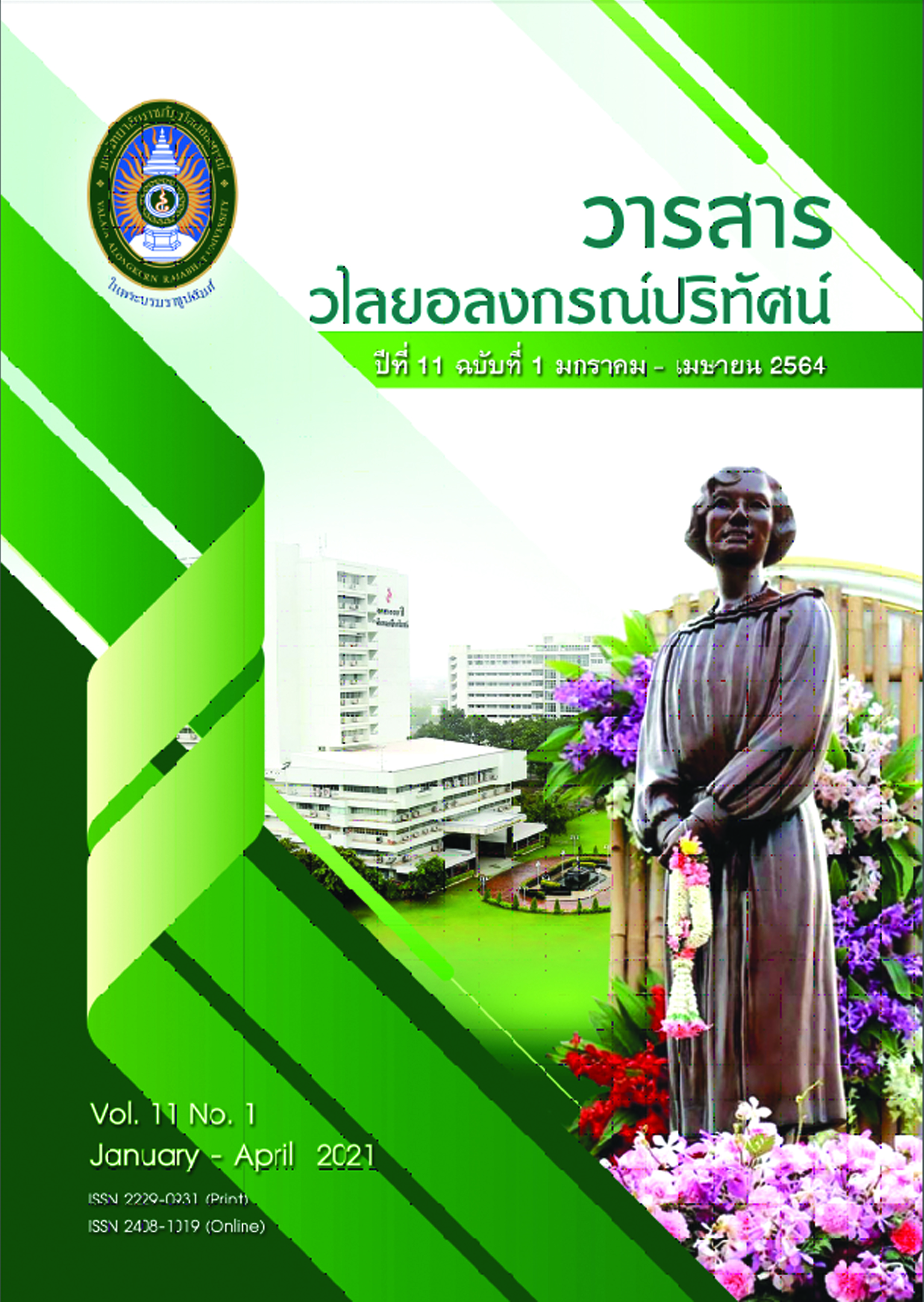ยุทธศาสตร์การพัฒนาการท่องเที่ยวเชิงวัฒนธรรมแบบมีส่วนร่วม วัดไชโยวรวิหาร อำเภอไชโย จังหวัดอ่างทอง
คำสำคัญ:
ยุทธศาสตร์การพัฒนา, การท่องเที่ยวเชิงวัฒนธรรม, วัดไชโยวรวิหารบทคัดย่อ
การวิจัยครั้งนี้มีวัตถุประสงค์เพื่อ 1) ศึกษายุทธศาสตร์การพัฒนาการท่องเที่ยวเชิงวัฒนธรรมของวัดไชโยวรวิหาร 2) ศึกษาพฤติกรรม ความคิดเห็น และความพึงพอใจของนักท่องเที่ยวที่เดินทางมาท่องเที่ยววัดไชโยวรวิหาร และ 3) วิเคราะห์ยุทธศาสตร์การพัฒนาการท่องเที่ยวเชิงวัฒนธรรม แบบมีส่วนร่วม วัดไชโยวรวิหาร โดยใช้ระเบียบวิธีวิจัยแบบผสานวิธีทั้งการวิจัยเชิงปริมาณและ เชิงคุณภาพ เก็บรวบรวมข้อมูลวิจัยเชิงปริมาณ โดยใช้เครื่องมือเป็นแบบสอบถามจากกลุ่มตัวอย่าง 400 คน วิเคราะห์ข้อมูลทางสถิติใช้ความถี่ ร้อยละ และค่าเฉลี่ย เก็บรวบรวมข้อมูลวิจัย เชิงคุณภาพ จากกลุ่มผู้เกี่ยวข้องกับการพัฒนาการท่องเที่ยว จำนวน 15 คน ซึ่งได้รับการคัดเลือกอย่างเฉพาะเจาะจงตามวัตถุประสงค์ของการวิจัยเป็นกลุ่มตัวอย่าง โดยการสัมภาษณ์แบบเจาะลึก การสนทนากลุ่ม การวิเคราะห์สภาพแวดล้อมภายในและภายนอก (SWOT Analysis และ TOWS Matrix) การจัดเวทีถอดบทเรียน และวิเคราะห์ข้อมูลโดยการวิเคราะห์เนื้อหา
ผลการวิจัยพบว่า
1. วัดไชโยวรวิหารเป็นแหล่งท่องเที่ยวเชิงวัฒนธรรมที่มีประวัติศาสตร์อันยาวนาน มีพระมหาพุทธพิมพ์เป็นพระพุทธรูปศักดิ์สิทธิ์ที่นักท่องเที่ยวให้ความเลื่อมใสศรัทธา มีกิจกรรมส่งเสริมการท่องเที่ยวคือ เทศกาลอาหารถิ่น กินผัดไทย ไหว้พระสมเด็จเกษไชโย มีภูมิปัญญาท้องถิ่นที่เป็นเอกลักษณ์คือ เครื่องจักสานด้วยไม้ไผ่บางเจ้าฉ่า นอกจากนี้ยังอยู่ใกล้กรุงเทพมหานคร สามารถเข้าถึงแหล่งท่องเที่ยวได้สะดวก รวมทั้งมีเส้นทางท่องเที่ยวที่สามารถเชื่อมโยงไปยังแหล่งท่องเที่ยวใกล้เคียง
2. นักท่องเที่ยวส่วนใหญ่ได้รับข้อมูลการท่องเที่ยวจากญาติ/เพื่อน และนิยมมาท่องเที่ยวในวันหยุดสุดสัปดาห์ มีวัตถุประสงค์เพื่อต้องการมาไหว้พระ/ทำบุญ สถานที่ที่นักท่องเที่ยวประทับใจมากที่สุดคือ รูปหล่อสมเด็จพุฒาจารย์โต และนักท่องเที่ยวมีความคิดเห็นต่อการจัดการท่องเที่ยวและความพึงพอใจในการมาท่องเที่ยววัดไชโยวรวิหารอยู่ในระดับมาก ปัญหาที่พบจากการมาท่องเที่ยวของนักท่องเที่ยวคือ มีร้านค้าให้บริการน้อย และเจ้าหน้าที่ที่ให้บริการภายในวัดยังไม่เพียงพอต่อความต้องการของนักท่องเที่ยว
3. ยุทธศาสตร์การพัฒนาการท่องเที่ยวได้วิสัยทัศน์คือ มีความเป็นเลิศด้านการท่องเที่ยวเชิงวัฒนธรรม มีพันธกิจ 5 ข้อ และมี 5 ยุทธศาสตร์ ได้แก่ 1) พัฒนาและส่งเสริมการท่องเที่ยว เชิงวัฒนธรรม 2) สนับสนุนเศรษฐกิจที่เข้มแข็งของชุมชน 3) ส่งเสริมการให้บริการและประชาสัมพันธ์การท่องเที่ยว 4) สนับสนุนการมีส่วนร่วมของประชาชนในการพัฒนาการท่องเที่ยว และ 5) การบริหารจัดการการท่องเที่ยว ซึ่งการประเมินยุทธศาสตร์โดยผู้เชี่ยวชาญพบว่า ยุทธศาสตร์ที่สร้างขึ้น มีความเหมาะสม
เอกสารอ้างอิง
กระทรวงการท่องเที่ยวและกีฬา. (2558). ยุทธศาสตร์การท่องเที่ยวไทย พ.ศ. 2558 - 2560. กรุงเทพฯ: กระทรวงการท่องเที่ยวและกีฬา.
กระทรวงการท่องเที่ยวและกีฬา. (2559). แผนพัฒนาการท่องเที่ยวแห่งชาติ พ.ศ. 2560 - 2564. กรุงเทพฯ: กระทรวงการท่องเที่ยวและกีฬา.
สำนักงานการท่องเที่ยวและกีฬาจังหวัดอ่างทอง. (2561). ข้อมูลด้านการท่องเที่ยวและกีฬาจังหวัด อ่างทอง. อ่างทอง: สำนักงานการท่องเที่ยวและกีฬาจังหวัดอ่างทอง.
สำนักงานการท่องเที่ยวและกีฬาจังหวัดอ่างทอง. (2561). แผนพัฒนาการท่องเที่ยวโดยชุมชน กลุ่มจังหวัดภาคกลางตอนบน 2. อ่างทอง: สำนักงานการท่องเที่ยวและกีฬา จังหวัดอ่างทอง.
Jose G. Vargea-Hernandez, (2012). Sustainable cultural and heritage tourism in regional development of Southern Jaliaco. World Journal of Entrepreneurship, Management and Sustainable Development, 8(2/3), 146-161.
Rodzi, N.I.M. Zaki, S.A. and Subli, S.M.H.S (2013). Between tourism and Intangible cultural heritage. Procedia-Social and Behavioral Sciences, 85, pp. 411-420.
Yamane, T. (1973). Statistics: an introductory analysis. New York: Harper & Row.
ดาวน์โหลด
เผยแพร่แล้ว
รูปแบบการอ้างอิง
ฉบับ
ประเภทบทความ
สัญญาอนุญาต

อนุญาตภายใต้เงื่อนไข Creative Commons Attribution-NonCommercial-NoDerivatives 4.0 International License.
ข้อความที่ปรากฏในบทความแต่ละเรื่องในวารสารวไลยอลงกรณ์ปริทัศน์ เป็นความคิดเห็นของผู้นิพนธ์แต่ละท่าน มิใช่เป็นทัศนะและมิใช่ความรับผิดชอบของกองบรรณาธิการจัดทำวารสาร และ
มหาวิทยาลัยราชภัฏวไลยอลงกรณ์ ในพระบรมราชูปถัมภ์


